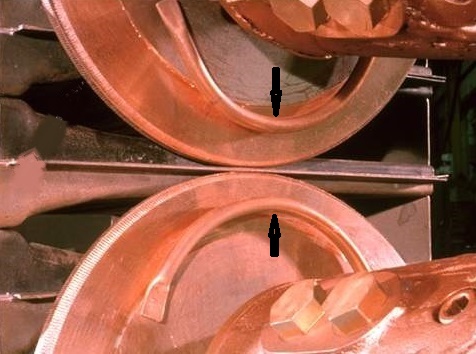Seam welding can generate large amounts of heat. Especially when making a liquid tight continuous weld. This heat is very visible at the actual weld joint. You stated that you are using cooling water as specified by the machine manufacturer at 20 l per minute. This may be adequate for the machine under normal operation. It does not mean that at the weld area the cooling is adequate.
Heat can be a suspect to address. The machine produces good welds for 300 meters. Then cracks appear. After stopping for a period of time the machine is cooled down. A restart produces good product for another 300 meters. If the hub cooling of the wheel cannot adequately cool the wheel to keep the wheel rim face at a steady heat condition, the rim face heat will build up and gradually get hotter. The part will not cool as quickly and the process will change. Apparently, CRACKING results.
Cooling of the part/wheel weld area with external direct water flood cooling as shown below is one option. This is messy but functional. The general rule of thumb is a flow rate of 4-6 l per minute.

ARROWS INDICATE FLOOD WATER TUBES
The other option is to attach a water cooling chamber on one face of the wheel. Use “O” rings to seal the water in and flood the chamber with water to near the weld face.
Is the Wheel rim face condition an issue?
• Is the wheel being faced/dressed during use?
• Does it build up and get rough and cause the cracks due to no dressing?
• When the machine stops do the wheels get dressed and produce good product until they get rough again?
Since heat is an issue one has to address the issue of the machine duty cycle. Is the machine operating safely at less than the normally rated 50% maximum duty cycle?
Several articles in this blog address Duty Cycle including:
HOW DO YOU CALCULATE DUTY CYCLE?
If the machine is nearing the 50% value then additional water cooling may be required. Cooling towers or Chillers may be needed.
Reference: RWMA – Resistance Welding Manual Section 4

